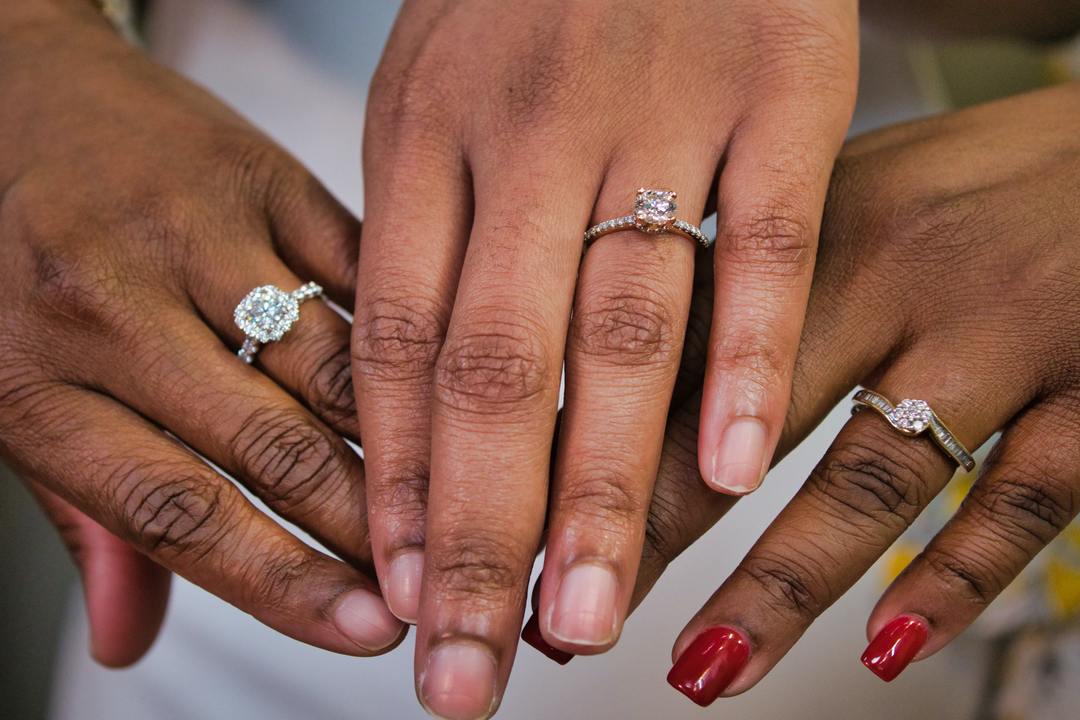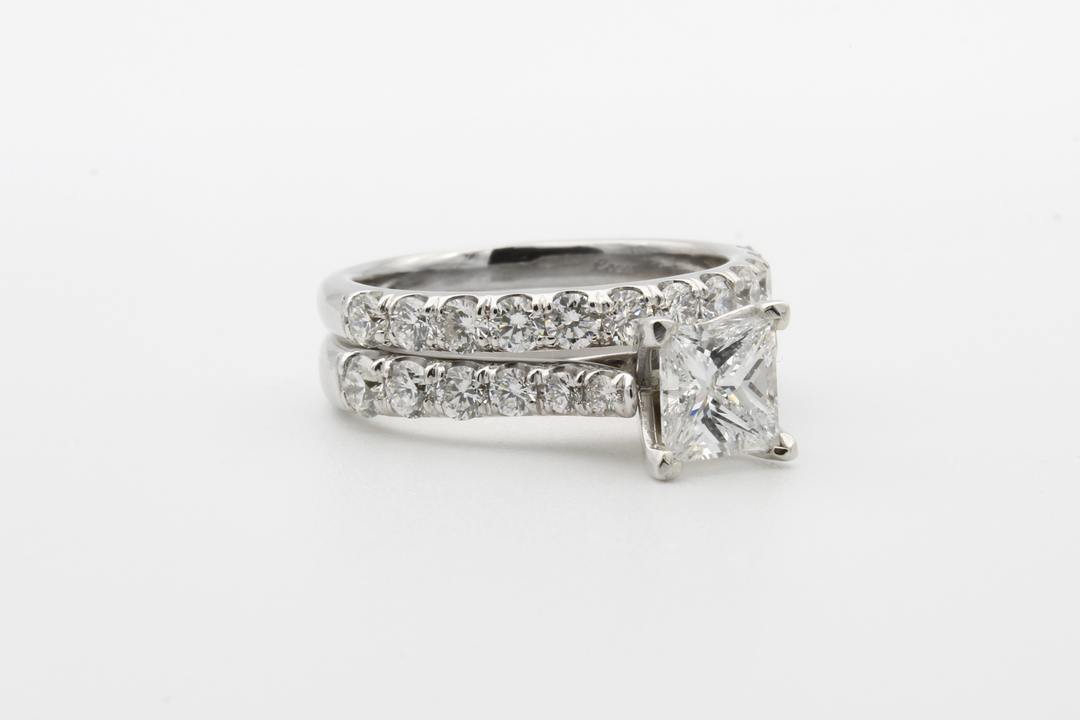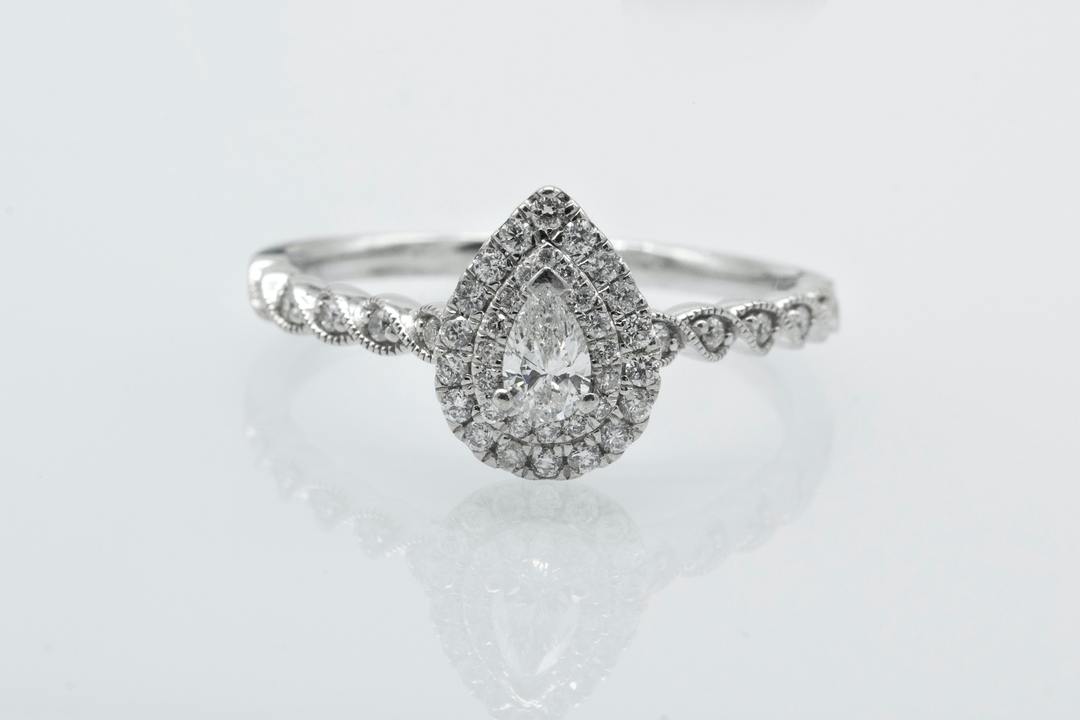- Expert advice/
- Getting engaged/
- Rings/
- What Are the Different Diamond Cut Options?
- Rings
What Are the Different Diamond Cut Options?
Getting ready to select the perfect engagement ring? Learn about the different diamond cut options with this informative guide.
Last updated February 5, 2024

If you’ve ever shopped for jewelry, or watched a wedding flick, chances are that you’ve heard of the 4Cs of diamond quality. This grading system—which judges the carat, cut, color, and diamond clarity—determines a stone’s overall quality. While each of the 4 Cs for diamonds is vital to selecting a high-value stone, many professionals feel the cut of a diamond is what really shapes the rock’s beauty—literally.
What Is a Diamond’s Cut?
A diamond’s cut refers to the quality of the diamond’s symmetry, angles, proportions, and finishing details, as well as its brilliance (the white light return, which is the foundation of a diamond's brightness), fire (the colored sparkle), and scintillation (overall sparkle). Basically, the cut quality determines how sparkly the diamond is. So, how is that graded? By the GIA’s diamond cut rating scale. The diamond cut rating scale places diamonds on one of six levels to rank the value of the cut. The grades, rated from best to least valuable, are: Ideal, Excellent, Very Good, Good, Fair, and Poor.

Diamond Shape vs. Diamond Cut
Now, this might come as a surprise to you, but the shape and cut of a diamond are actually different. The shape is the outline or external figure of the diamond. This is where considerations such as cushion, round, and pear come up. The cut, of course, refers to a diamond’s symmetry and reflective qualities. While the cut doesn’t affect the shape of the diamond, the shape does affect the cut, since some cuts aren’t available or viable. Since shape and cut are so often intertwined, we’re breaking down the most popular diamond cuts and shapes to help you find the rock that shines brightly, whatever the silhouette may be.
The Most Popular Diamond Cuts
The very first step in selecting a diamond is to choose the desired shape. If you’re shopping for someone else, peek at their Pinterest board or ask a friend—odds are your special someone has a shape in mind. From there, the next step is finding the most appealing cut that you can afford in that shape. As a general rule, the finer the cut of a diamond, the greater the level of brilliance and fire.
For plenty of brilliance, choose a cut grade of at least very good for a round cut diamond. If you have a fancy shape (non-round shapes), a good or better cut should suffice in the sparkle department (sometimes even a fair cut will get the job done, if you want to splurge on a different “C”). While there are lots of cuts and shapes out there, here are the most popular diamond cuts to help you narrow down your choices.
Round
Round brilliant cut represents close to 75 percent of the diamonds sold. This is the most classic diamond cut, and for good reason. The refined shape and cut of the round diamond has 58 facets (sides), which allow maximum reception of light and impressive brilliance. Downsides: Since round brilliant cuts are the most popular, they’re also the most pricey. The most expensive upcharge for a round diamond tends to be around the one-carat size, since that’s also the most popular diamond weight for an engagement ring. Cost: $4,200 (1.00 carat; very good cut; F color; SI1 clarity)
Princess
The second most popular cut shape (and the most popular fancy cut), a princess cut diamond is traditionally square (but you can find rectangular shaped stones, too) and provides ample fire and brilliance. These gorgeous cuts tend to come in at about a ¼ less in cost than similarly graded round brilliant cut diamonds, but maintain a similar sparkle. Downsides: The sharp corners of a princess cut diamond can easily snag or chip, so make sure that they’re securely pronged and free from inclusions. Cost: $3,300 (1.01 carat; very good cut; G color; SI1 clarity)
Oval
If you love the brilliance of rounds, but want a more unique cut that elongates the finger, the oval (made popular by Blake Lively) is a fantastic choice—thanks in part to being a modified brilliant cut. Not only do they have a larger face-up surface area, but they‘re typically about 10 percent less than comparable round cut diamonds. Downsides: Almost all oval cuts exhibit a bowtie pattern in the middle. Some are more prominent than others, but it’s something to keep in mind when shopping. Cost: $3,750 (1.00 carat; very good cut; I color; VVS2 clarity)
Cushion
One of the oldest cuts around, cushion cuts are gaining in popularity again thanks to their brilliant fire and vintage feel—they perfectly mix old and new. The combination of a square shape with rounded edges is the reason for the name, and it’s lower price point (at about 20-40 percent cheaper than a comparable round cut) makes it a choice for anyone after a unique, yet timeless cut. Downsides: While there are a lot of pros to a cushion cut diamond, the face-up area is about eight percent smaller than an equivalent round cut diamond. Cost: $2,600 (1.01 carat; very good cut; I color; VVS2 clarity)
Pear
Shaped like their name, pear diamonds have a rounded side that narrows to a point (which points toward the heart of the wearer, much like a Claddagh ring). This elegant cut is a combination of a round and a marquise shape with a modified brilliant cut. Not only does it have a larger face-up surface area than comparable rounds, but they’re normally about 20 percent less in price. Downsides: Make sure that the point is inclusion-free (which could cause chipping or breakage) and still, be careful as the tip can cause snags. Additionally, like the oval cut, pear cuts exhibit bowtie patterns, so you might need to shop around a bit to find a rock that feels perfect. Cost: $3,750 (1.01 carat; very good cut; E color; SI2 clarity)

Radiant
Since the ‘80s, radiant cuts have grown increasingly popular and are actually one of the most brilliant cuts available (because they are a modified brilliant cut). With tons of sparkle, durability, and an elongated face, radiant cuts can appear larger than round cuts, yet generally come in at about 20 percent cheaper. Extra bonus: Flaws and inclusions are easily hidden thanks to its multi-faceted cut. Downsides: While radiant cuts can sometimes appear larger than round cuts, in reality, their face-up size is relatively smaller by around five percent. Cost: $4,000 (1.03 carat; very good cut; H color; VS1 clarity)
Emerald
Emerald cut diamonds get their name due to the fact that the same technique used to cut emeralds is used. The elongated shape offers a slimming effect on the finger and its large surface table offers lots of reflection, but in a different way than round brilliant cuts (more like a shimmering “hall of mirrors” effect over a fiery sparkle). In addition to their unique shape and cut, an emerald cut diamond tends to be anywhere from 10-40 percent cheaper than comparable round cut diamonds. Downsides: While an emerald cut’s large table is elegant, it makes inclusions more noticeable than brilliant cut diamonds. Additionally, an emerald cut diamond has a smaller face-up surface area by about five percent and can appear even smaller due to their lack of brilliance. Cost: $3,400 (1.00 carat; very good cut; H color; VVS2 clarity)
Asscher
Similar to the emerald cut, the asscher cut diamond has a smaller table and more layered facets, which creates brilliance through light reflection. The asscher cut, however, has trimmed corners, which provides extra stability and creates more sparkle due to its 50 facets. Perfect for an Art Deco look, these octagonal-shaped diamonds cost anywhere from 20-40 percent less than their equivalent rounds. Downsides: The asscher cut has the smallest face-up area of the fancy cuts, and 13 percent less face-up surface area than round brilliant cuts. Additionally, this step-cut doesn’t hide inclusions as well as brilliant cuts and, therefore, needs to be a higher clarity grade. Cost: $3,500 (1.01 carat; very good cut; H color; VVS1 clarity)
Marquise
Renowned for its unique look, the marquise diamond resembles an elongated eye, and its length gives the appearance of a larger stone. In fact, it has the largest face-up surface area of all diamond cuts (about 15 percent larger than rounds). Even though they’re a modified brilliant cut, they usually run at least 10 percent under the cost of a similar caliber round brilliant cut diamond. Downsides: The tapered points of a marquise cut diamond can easily get snagged, so ensure that they’re tightly pronged and without any inclusions to prevent chipping or breakage. This is another cut where a bowtie pattern will take place, and due to its length, symmetry is especially important to its overall integrity. Cost: $4,000 (1.02 carat; very good cut; F color; SI1 clarity)
Heart
The definition of romantic, heart shaped diamonds are exactly like the name hints: They’re shaped like hearts. This unique shape is popular for solitaire rings, and it’s a modified brilliant cut, so it provides plenty of sparkle. While the cut isn’t for anyone, it’s a dreamy choice for those in love with all things love, and they run between 10-25 percent less than comparable round brilliant cuts. Downsides: The tip of the heart can snag or break, so make sure that it’s secured with a prong, and is inclusion-free in the narrow area. Additionally, the shape is hard to make out in diamonds smaller than ½ a carat, which can make them hard to evaluate. Cost: $3,000 (1.01 carat; very good cut; H color; SI1 clarity) Whichever cut you choose, evaluate how it shines, select a grade within your price range, and remember that it’s the promises behind the diamond that truly make it dazzle.
- Expert advice/
- Getting engaged/
- Rings/
- What Are the Different Diamond Cut Options?
Find even more wedding ideas, inspo, tips, and tricks
We’ve got wedding planning advice on everything from save the dates to wedding cakes.